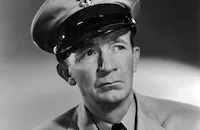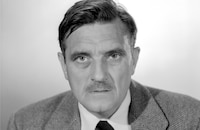Drums Across the River
Brief Synopsis
Cast & Crew
Nathan Juran
Audie Murphy
Walter Brennan
Lyle Bettger
Lisa Gaye
Hugh O'brian
Photos & Videos
Film Details
Technical Specs

Synopsis
Crown City, Colorado, once a busy gold mining town, is now miles away from the nearest gold vein, which lies across the San Juan River, in Ute Indian country. Many of the townspeople have been driven to desperation by hard times, including Gary Brannon, who, with his father Sam, operates a freight company. Gary falls in with a group of men, led by Frank Walker, who are planning to seize gold-rich land located in territory assigned to the Ute Indians as part of a peace treaty. On the night of their planned river crossing, Sam tries unsuccessfully to dissuade Gary from joining the men. While Sam has maintained a delicate friendship with the Ute chief, Ouray, Gary harbors deep resentment for the Utes, who killed his mother. Sam is determined to stop Walker and his men from using Gary and Nathan Marlowe, the first settler of Crown City, to start a war with the Indians, and follows their wagons. Sam catches up with the raiding party just in time to prevent his son from killing the chief's son, Red Knife, and urges him instead to use the Indian as a hostage. During a gun battle between a Ute hunting party and Walker's men, Sam manages to bring about a temporary cease-fire by telling the Utes that they have Red Knife, and that they will turn him over only when the Utes release their hostage, Marlowe. The next day, as Sam prepares the hostage exchange, Walker signals his men to fire at the Indians, and the temporary truce is broken. When Sam is wounded in the gun battle, Gary realizes that his father is right, and decides to sever his ties with Walker. Gary later tells the Ute chief that only a small band of instigators are responsible for the recent fighting. The dying Ouray does not believe the white man's promises of peace, but instructs his son Taos to deliver Gary safely home. Gary arrives in Crown City just in time to prevent Walker and his men from marching on the Ute village. Walker, however, quickly devises a new plan to get his men across the San Juan River again: He takes Sam hostage and coerces Gary into robbing a gold-filled stagecoach, killing its driver and guard, and planting evidence implicating the Utes. After he has been convicted of the crime and preparations are made for his hanging, Gary sends a message to Walker, offering, in exchange for his freedom, to tell him where he hid the gold shipment. The ploy works, and Sam is sent to break his son out of prison and deliver him to Walker. Instead of leading Walker and his men to the gold shipment, though, Gary takes them to the sacred Ute burial ground, knowing that the Indians will engage the men in a bloody battle there. After the Indians massacre Walker's gang, Gary proudly observes the signing of a new treaty with the Indians, and looks forward to starting a new life with his sweetheart Jennie.

Director
Nathan Juran
Cast

Audie Murphy

Walter Brennan

Lyle Bettger

Lisa Gaye
Hugh O'brian

Mara Corday
Jay Silverheels
Emile Meyer

Regis Toomey

Morris Ankrum

Bob Steele
James Anderson
George Wallace
Lane Bradford
Howard Mcnear

Gregg Barton
Ken Terrell
Phil Chambers
Chief Yowlachie
Steve Darrell
Ewing Mitchell
Edmund Cobb
Cliff Lyons
Robert Bray
Andy Brennan
Rusty Wescoatt

Larry Williams
Joseph Morrisey
Brick Sullivan
Steve Raines
Harry Raven
Lee Morgan
Crew
Gene Anderson
Monroe W. Burbank
John K. Butler
John K. Butler
Leslie I. Carey
Richard Deweese
Russell A. Gausman
Joseph Gershenson
Julia Heron
Bernard Herzbrun
Harold Lipstein
Jay Morley Jr.
Richard H. Riedel
Lawrence Roman
Tom Shaw
Joan St. Oegger
Melville Tucker
Virgil Vogel
James Welch
Bud Westmore

Photo Collections
Film Details
Technical Specs

Articles
Drums Across the River
In this one, Murphy plays Gary Brannon, a young wagon freighter in a Colorado mining town of the 1880s whose quiet life with his father (Walter Brennan) is thrown into chaos when sneaky businessman Frank Walker (Lyle Bettger) tries to stir up a war between the Ute Indians and the townspeople because the only gold left to mine in the area is on Indian lands in the San Juan Mountains. Meanwhile, Walker forces Brannon into participating in a Wells Fargo robbery by abducting his dad and threatening to kill him. Charged with murder after the robbery, Brannon escapes to try and save his dad, clear his name and, despite his hatred of Indians, prevent a confrontation between the Utes and the cavalry. All these plot developments are laid out and resolved in a mere 78 minutes.
Playing an important role in the action is Jay Silverheels as Taos, the warrior son of Ute chief Ouray (Morris Ankrum). Mara Corday plays a voluptuous saloon girl who is friendly with Bettger; future Wyatt Earp star Hugh O'Brian is a black-clad gunman with a deadly smile; and Lisa Gaye, sister of the better-known Debra Paget, provides Murphy's love interest. Also on hand is a lineup of colorful character types including James Anderson, George Wallace, Lane Bradford, Robert Bray and former B-Western star Bob Steele, who enjoys a rousing fight scene with Murphy. Silverheels, on leave from playing Tonto in The Lone Ranger series, delivers a solemn, regal performance. Brennan does his usual audience-pleasing work, and Bettger, a leading villain of the period, is smoothly compelling. Murphy himself earned a favorable reaction from reviewer Hal Erikson, who found him to be "at his taciturn best."
According to later interviews, Murphy's leading ladies had quite different opinions of him. "Audie was psychotic -- insane!" said Mara Corday. "After killing all those people during the war, you'd have to be a little nuts!... Audie was very quiet, soft-spoken and boyish -- yet a flirt with the girls. But he had a short fuse, so you walked around on eggshells whenever he was near." Lisa Gaye: "Audie was a gentleman -- always! Friendly. Of course, I was still a teenager when we worked together, but he was very nice, very protective of me. Audie was like a big brother to me."
The Films of Audie Murphy authors Bob Larkins and Boyd Magers write that, "During the filming of Drums Across the River, for realism, Audie insisted the prop guns be loaded with full charges instead of the usual quarter loads. Consequently, when Hugh O'Brian carelessly fired off his pistol near Audie's face, Murphy received powder burns on his face and neck."
The Technicolor film was shot partly on the Universal backlot, with some vivid location filming at Barton Flats in California's San Bernardino Mountains.
Producer: Melville Tucker
Director: Nathan Juran
Screenplay: John K. Butler (story and screenplay); Lawrence Roman (screenplay)
Cinematography: Harold Lipstein
Art Direction: Bernard Herzbrun, Richard H. Riedel
Music: Henry Mancini, Herman Stein
Film Editing: Virgil Vogel
Cast: Audie Murphy (Gary Brannon), Walter Brennan (Sam Brannon), Lyle Bettger (Frank Walker), Lisa Gaye (Jennie Marlowe), Hugh O'Brian (Morgan), Mara Corday (Sue Randolph), Jay Silverheels (Taos), Emile Meyer (Nathan Marlowe), Regis Toomey (Sheriff Jim Beal), Morris Ankrum (Chief Ouray).
C-78m.
by Roger Fristoe

Drums Across the River
Quotes
Trivia
Notes
According to Universal press materials, some scenes were shot on location in the Angeles National Forest, Chatsworth, the Mojave Desert and Kernville, CA. The Ute territory in Colorado, which had recently been damaged in a forest fire, was recreated for the film.














